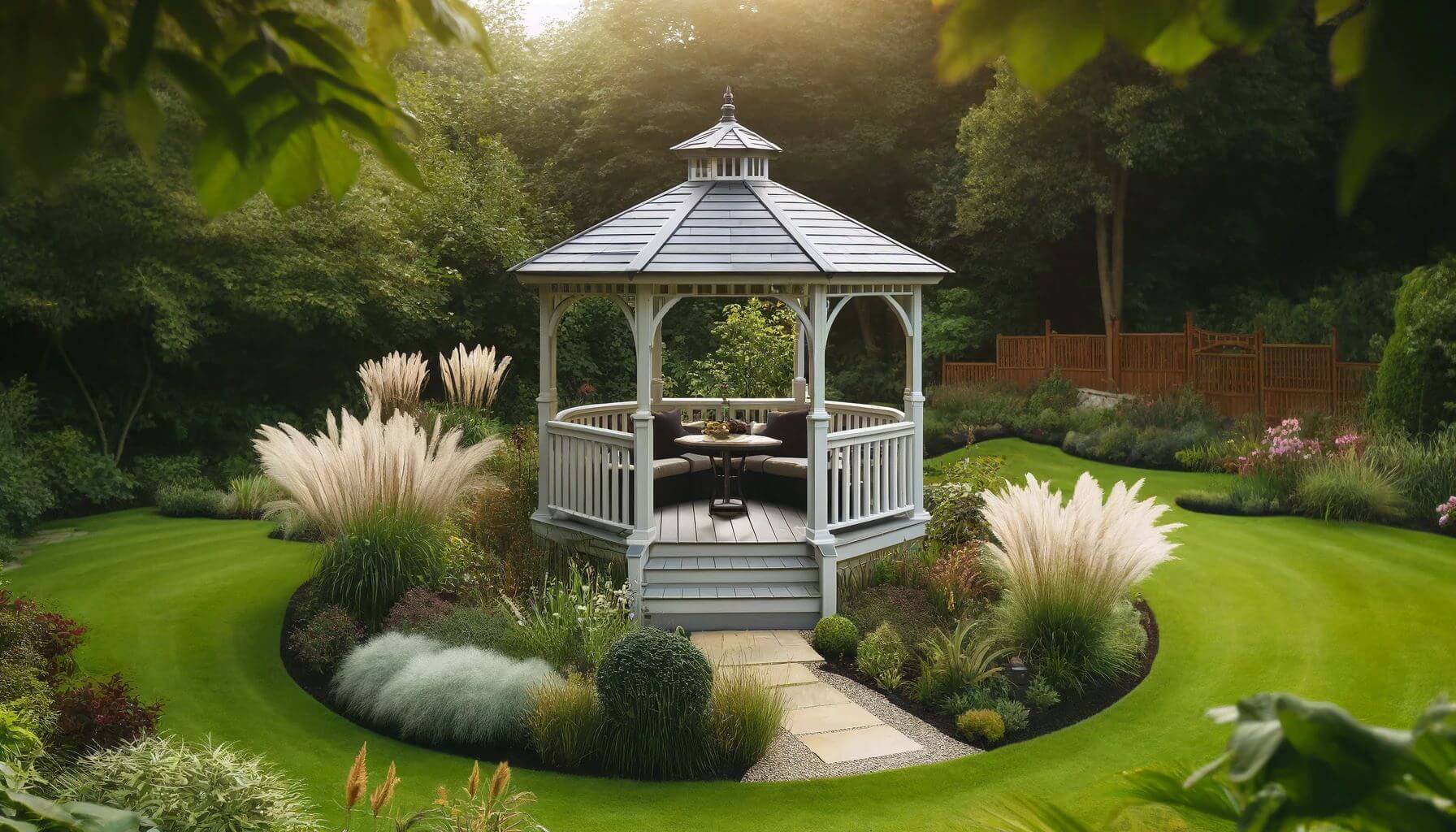
Gazebos have long been cherished as elegant additions to home landscapes across the globe. These standalone structures are celebrated not only for their aesthetic appeal but also for their practical benefits. Traditionally designed with an open framework and a roof, gazebos provide a picturesque sanctuary from the daily grind. In this article, we will explore the beauty and utility of gazebos, offers innovative design ideas, and discusses material options along with styling tips to integrate a gazebo into your outdoor living space seamlessly.
Benefits of a Backyard Gazebo
Aesthetic Appeal
A gazebo can transform an ordinary backyard into a stunning landscape feature. It serves as an architectural focal point, drawing the eye and complementing the natural beauty of its surroundings. The right gazebo will harmonize with your garden’s theme and elevate the overall aesthetic of your home.
Functional Uses
Gazebos are versatile additions to any garden, providing shade on sunny days and shelter during unexpected rain. These structures create a private haven in your backyard and a comfortable space for entertaining guests. With the addition of screens and doors, a gazebo can also offer a bug-free outdoor dining or lounging area, increasing the usability of your garden.
Increased Property Value
Investing in a well-crafted gazebo can lead to a significant return by boosting your property’s market value. It enhances the livability and charm of outdoor spaces, making your home more attractive to potential buyers should you decide to sell.
Choosing the Right Backyard Gazebo for Your Space
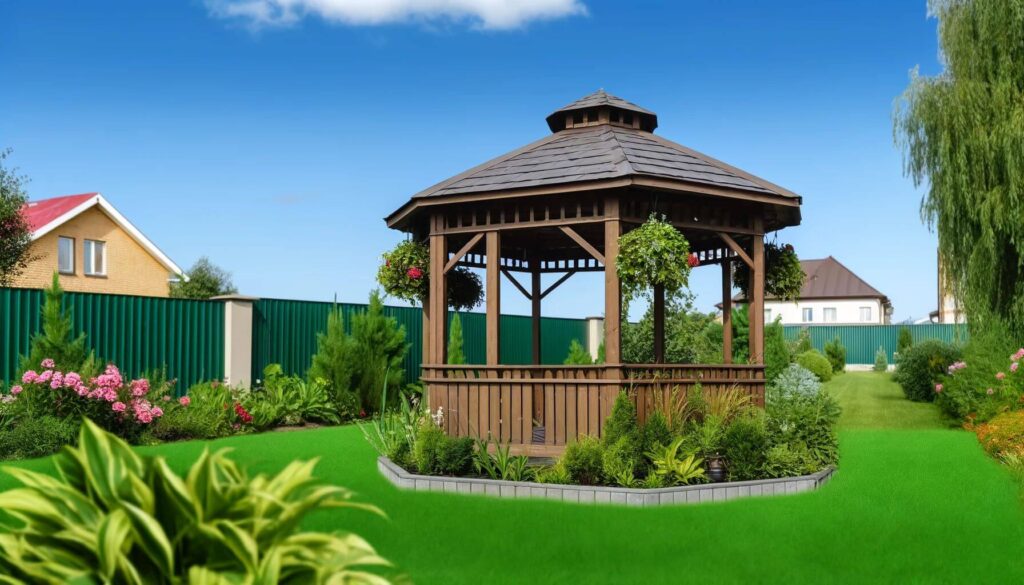
Assessing Your Needs
Before selecting a gazebo, consider its primary function in your outdoor space. Whether you aim to use it for entertainment, relaxation, or dining, the purpose will guide your decisions on size, shape, and materials. Think about the activities you envision hosting; this will help in tailoring the gazebo to meet your lifestyle needs.
Size and Shape
The right size and shape of the gazebo are crucial for balance and functionality in your garden. Assess the area available in your backyard. A large garden might accommodate a grand octagonal gazebo, while a smaller space might benefit from a compact square or rectangular structure. Ensure there is ample room around the gazebo for movement and landscaping enhancements.
Material Selection
Choosing the right material for your gazebo depends on the style of your garden and the level of maintenance you can commit to:
- Wood (pine, cedar, redwood): Offers a classic and rustic look that blends naturally with outdoor settings. Wood requires regular staining and treatment to maintain its condition and appearance.
- Metal (iron, steel, aluminum): Provides a sleek, modern aesthetic and is more durable than wood. Metal gazebos are robust and require minimal upkeep, making them a popular choice for those looking for longevity without frequent maintenance.
- Vinyl: A cost-effective alternative that withstands weather elements well and mimics the look of wood. Vinyl is easy to clean and does not need painting or staining, appealing for those seeking a low-maintenance option.
Design Ideas for Gazebos
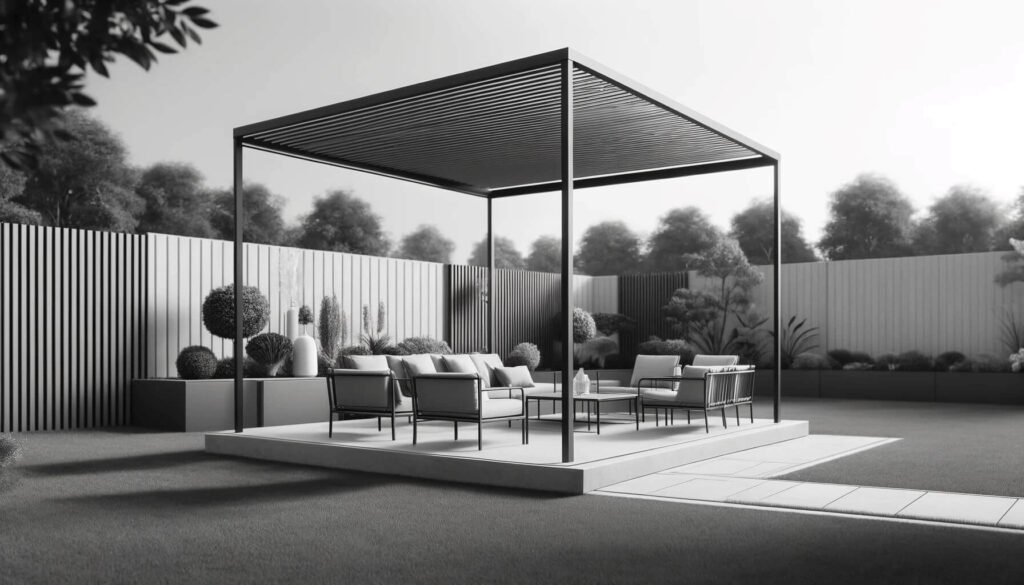
Traditional Designs
The architecture of a gazebo can significantly impact the look and feel of your garden. Traditional styles like Victorian, Amish, and Rotunda gazebos offer elegance and classic charm. These designs often feature intricate woodwork, shingled roofs, and may include cupolas for a distinctive silhouette against the sky.
Modern Twists
For a contemporary backyard, consider a gazebo with a minimalist design. Modern gazebos typically involve clean lines and are constructed from metal or mixed materials. These structures can be outfitted with modern conveniences such as solar panels on the roof and built-in lighting for evening use.
Custom Features
Customizing your gazebo can add functionality and comfort. Consider these additions:
- Built-in Seating: Benches or seats built into the structure provide permanent, hassle-free seating solutions.
- Screens for Insects: Adding screens to the openings can make your gazebo a bug-free zone, enhancing comfort during use.
- Ceiling Fans: Install ceiling fans to keep the area cool on hot days, making your gazebo a pleasant retreat throughout the warmer months.
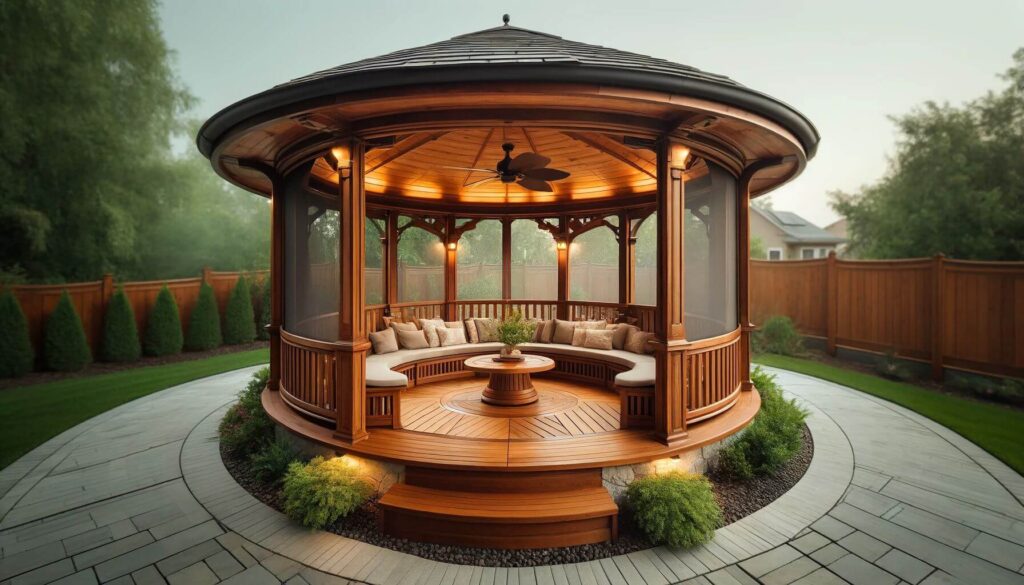
Integrating Your Gazebo With Outdoor Decor
Location and Placement
Selecting the perfect spot for your gazebo involves more than just finding available space; it requires strategic planning to maximize both utility and aesthetic appeal. Place your gazebo to offer picturesque views of your garden or surrounding landscape. Consider the path of the sun through the day; positioning your gazebo to provide afternoon shade can increase its comfort and usability. Also, think about access from your house and visibility to improve security.
Landscaping Ideas
The right landscaping can transform the area around your gazebo into a lush, inviting retreat:
- Climbing Vines: Plant climbing vines like ivy, clematis, or wisteria to soften the structure’s edges and integrate it with the garden. These plants can also provide additional shade and privacy.
- Surrounding Flower Beds: Install flower beds with perennial blooms around the gazebo to boost its beauty year-round. Consider flowers that match or complement the color scheme of the gazebo for a cohesive look.
Furniture and Accessories
Furnish your gazebo to maximize comfort and style:
- Soft Furnishings: Add cushions and throws for added comfort. Choose weather-resistant fabrics in colors that complement the natural surroundings.
- Lighting Options: Incorporate various lighting options such as fairy lights, LED strips, or a chandelier to create the right mood and enhance evening use.
- Outdoor Rugs and Art: Place outdoor rugs to define the space and add color and texture. Select weather-proof wall art or sculptures to personalize the space.
Installation Tips and Maintenance
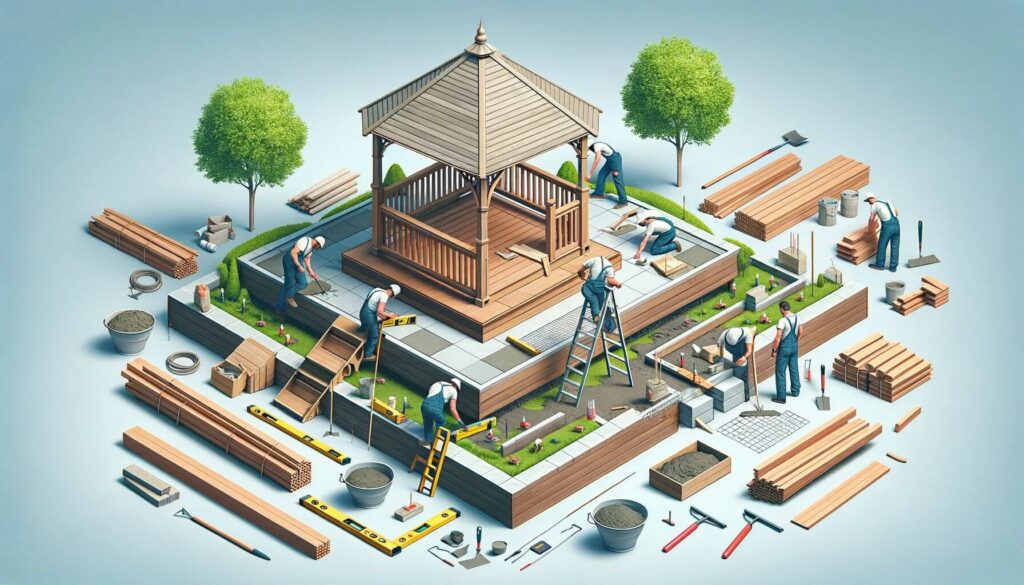
DIY vs. Professional Installation
Installing a gazebo can be a substantial project, and deciding between DIY and professional installation comes down to skill level and budget:
- DIY Installation: Offers a cost-effective way to erect your gazebo if you have the necessary tools and expertise. It allows for a personalized touch but requires significant time and effort.
- Professional Installation: While more costly, hiring professionals ensures that the gazebo is set up correctly and securely. It is advisable for those who prefer a hassle-free and quick installation.
Preparing the Site
Proper site preparation is crucial for a durable and stable gazebo:
- Foundation Setting: Whether you choose a concrete foundation, paving stones, or a wooden base, ensure the ground is level and stable. This step prevents structural issues and enhances the gazebo’s longevity.
- Site Preparation: Clear the area of debris and vegetation. Measure and mark out the exact dimensions before starting the installation process.
Maintenance Practices
Regular maintenance keeps your gazebo in prime condition and extends its life:
- Routine Cleaning and Inspections: Clean the gazebo regularly to prevent dirt buildup; inspect for damage or wear, especially after severe weather.
- Seasonal Preparations: Prepare your gazebo for different weather conditions; e.g., securing loose elements before winter storms, or adding waterproof treatments.
- Long-term Care for Different Materials: Each material needs specific care; wood may require periodic staining or sealing, metal may need rust protection, and vinyl typically needs little more than regular cleaning.
Enhancing Your Outdoor Living Space with a Gazebo
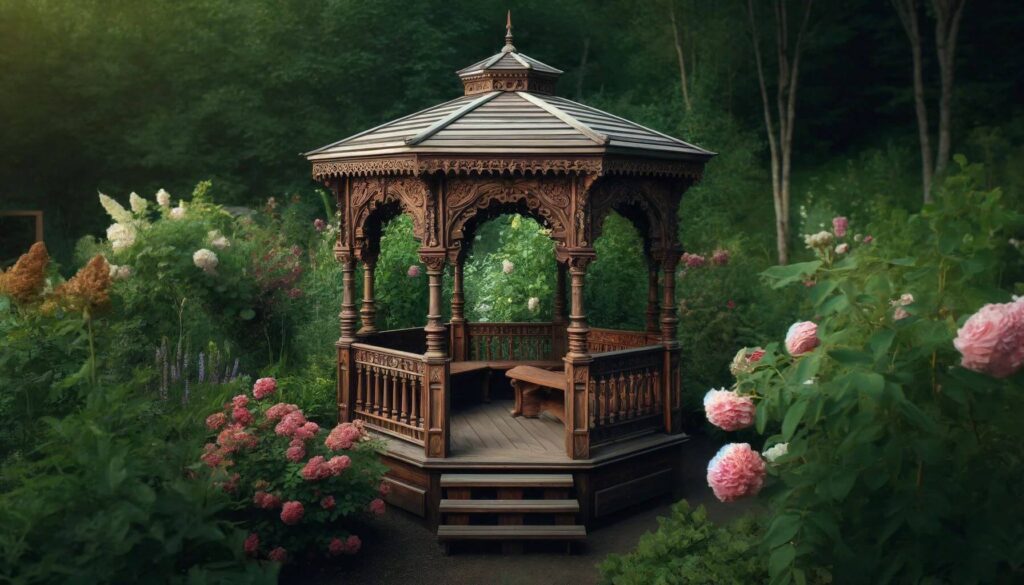
Gazebos are more than just decorative elements; they add significant value and functionality to outdoor spaces. These structures provide a tranquil retreat, enhance the beauty of a garden, and become the centerpiece for gatherings. Thorough planning regarding the type, style, and materials of your gazebo will ensure it fits perfectly with your outdoor decor and meets your needs.
Choosing the right backyard gazebo involves understanding the landscape of your garden, the typical weather conditions, and your aesthetic preferences.
FAQ
- What is the best material for a gazebo?
- The ideal material for a gazebo varies depending on your climate, maintenance capacity, and design preference. Wood, metal, and vinyl are popular choices, each offering different benefits regarding appearance and upkeep.
- How do I choose the right size for my gazebo?
- Select a size that fits well within your garden space without overcrowding it. Sizes typically range from 8’x8’ for more intimate settings to 20’x20’ for hosting larger groups.
- Can I install a gazebo by myself?
- Self-installation is feasible for simpler models if you are handy and have the necessary tools. However, for complex or large designs, professional help is recommended to ensure safety and stability.
- How do I maintain my gazebo?
- Maintenance involves regular cleaning to remove dirt and debris, applying protective treatments to wood surfaces, and checking for structural integrity periodically, especially after extreme weather events.
- What are the best plants to grow around a gazebo?
- Climbing plants like roses, jasmine, ivy, and honeysuckle are excellent for creating a natural, lush look. These plants also help integrate the gazebo into the surrounding landscape seamlessly.
- Are permits required for building a gazebo?
- In many areas, a permit may be necessary depending on the gazebo’s size and structure. Always verify local building codes and regulations before starting your project.
- Can a gazebo be used year-round?
- Yes, with the proper setup that might include screens to block insects, heaters for the cold months, and materials suitable for all weather conditions, a gazebo can be a year-round haven.
- What are the latest trends in gazebo design?
- Recent trends include the use of mixed materials to combine aesthetics and durability, eco-friendly options like sustainable wood or recycled materials, and smart features such as built-in lighting and audio systems for an enhanced experience.
- How do I make my gazebo bug-proof?
- To minimize bugs, install screens on the windows and doors of your gazebo. Additionally, using net curtains and natural repellents like citronella candles or essential oils can help keep the area comfortable and pest-free.



